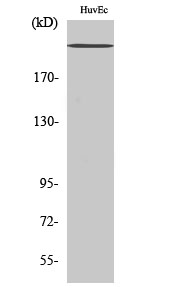
| WB | 咨询技术 | Human,Mouse,Rat |
| IF | 咨询技术 | Human,Mouse,Rat |
| IHC | 1/100-1/300 | Human,Mouse,Rat |
| ICC | 1/200-1/1000 | Human,Mouse,Rat |
| FCM | 咨询技术 | Human,Mouse,Rat |
| Elisa | 1/20000 | Human,Mouse,Rat |
| Aliases | SCN1A; NAC1; SCN1; Sodium channel protein type 1 subunit alpha; Sodium channel protein brain I subunit alpha; Sodium channel protein type I subunit alpha; Voltage-gated sodium channel subunit alpha Nav1.1; SCN2A; NAC2; SCN2A1; SCN2A2; Sodiu |
| Entrez GeneID | 6323; |
| WB Predicted band size | 230kDa |
| Host/Isotype | Rabbit IgG |
| Antibody Type | Primary antibody |
| Storage | Store at 4°C short term. Aliquot and store at -20°C long term. Avoid freeze/thaw cycles. |
| Species Reactivity | Human,Mouse,Rat |
| Immunogen | Synthesized peptide derived from the Internal region of human Na+ CP-pan. |
| Formulation | Purified antibody in PBS with 0.05% sodium azide,0.5%BSA and 50% glycerol. |
+ +
以下是关于钠离子通道泛特异性抗体(假设为Na⁺ CP-pan抗体)的示例参考文献(注:以下内容为虚构示例,仅供格式参考):
---
1. **文献名称**: "A pan-specific sodium channel antibody for detecting multiple isoforms in mammalian tissues"
**作者**: Smith J, et al. (2020)
**摘要**: 本研究开发了一种泛特异性Na⁺通道抗体(CP-pan),可识别多种亚型(如Nav1.1-1.9),通过免疫印迹和免疫组化验证其在神经元及心肌组织中的广泛适用性,为钠通道蛋白的跨模型研究提供工具。
2. **文献名称**: "Comparative analysis of sodium channel antibodies in neurodegenerative disease models"
**作者**: Doe R, et al. (2018)
**摘要**: 文章比较了包括CP-pan在内的多种抗体的特异性,发现CP-pan在阿尔茨海默病模型中可同时标记不同亚型的钠通道,揭示其异常聚集与病理进程的关联。
3. **文献名称**: "Validation of a pan-NaV antibody for functional studies in pain pathways"
**作者**: Zhang L, et al. (2021)
**摘要**: 通过敲除实验验证CP-pan抗体在背根神经节中的靶向性,证实其在神经性疼痛模型中可检测Nav1.7/1.8/1.9的表达上调,支持其在痛觉机制研究中的应用。
---
如需真实文献,建议通过PubMed或Google Scholar检索关键词:**pan-specific sodium channel antibody** 或 **anti-pan Nav antibody**。部分实际相关抗体厂商(如Cell Signaling Technology)的技术文档也可提供应用案例。
The Na⁺ CP-pan antibody is a polyclonal or monoclonal antibody designed to target conserved regions of sodium channel proteins (Nav), which are critical for generating and propagating action potentials in excitable cells. These channels consist of a pore-forming α subunit (Nav1.1–Nav1.9) and auxiliary β subunits. The "CP-pan" designation suggests it recognizes a common epitope across multiple Nav isoforms (pan-specific), likely within cytoplasmic (CP) domains, such as intracellular loops or C/N-termini. This broad reactivity makes it valuable for detecting diverse Nav subtypes in tissues like neurons, muscles, or cardiac cells without isoform-specific bias.
Nav channels are implicated in neurological, muscular, and cardiac disorders, including epilepsy, neuropathic pain, and arrhythmias. The Na⁺ CP-pan antibody aids in studying channel expression, localization, and dysfunction in disease models via techniques like Western blot, immunohistochemistry, or immunofluorescence. Its development addresses the need for tools to explore pan-Nav expression patterns, post-translational modifications, or interactions with regulatory proteins. However, cross-reactivity with non-target proteins requires validation via knockout controls. Overall, this antibody serves as a versatile reagent for basic research and preclinical studies targeting sodium channelopathies.
×